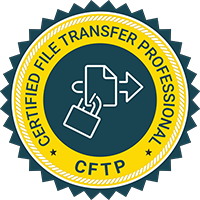What protocol should I use and why?
What protocol should I use?
 This blog post answers your questions about File Transfer protocols. Which are the most widely used file transfer delivery protocols? Which should you be using and how do you identify which solution, whether it be it Managed File Transfer or Secure File Transfer, uses which protocols?
This blog post answers your questions about File Transfer protocols. Which are the most widely used file transfer delivery protocols? Which should you be using and how do you identify which solution, whether it be it Managed File Transfer or Secure File Transfer, uses which protocols?
A protocol is the set of rules that determines how files are transferred from one computer to another, through a network. That might be an internal network (from one computer to another within the same network) or more commonly a Wide Area Network such as the internet.
The nature of your data and its destination will determine the right protocol for the transfer. For example, personally identifiable data and credit card information will need a secure protocol.
BASIC PROTOCOLS
FTP
(File transfer protocol)
How can it be used?
✓ Upload/download files
✓ Rename and delete files
✓ Create/delete folders
✓ Execute custom commands on server
✓ Check integrity of files
When can it not be used?
X Secure data at rest
X Secure data in transit (FTPS can)
X Work over just one firewall port
X Provide strong authentication
FTPS
(“FTP Secured” using SSL)
✓ Secure data in transit
✓ Upload/download files
✓ Rename and delete files
✓ Create/delete folders
✓ Execute custom commands on server
✓ Check integrity of files
✓ Provide strong authentication
X Secure data at rest
X Work over just one firewall port
SFTP
(“Secure FTP” using SSH)
✓ Secure data in transit
✓ Upload/download files
✓ Rename and delete files
✓ Create/delete folders
✓ Provide strong authentication
✓ Work over just one firewall port (22)
X Secure data at rest
X Check integrity of files
X Execute custom commands on server
SCP
(“Secure CoPy”)
✓ Secure data in transit
✓ Upload/download files
✓ Work over just one firewall port (22)
✓ Provide strong authentication
X Rename and delete files
X Create/delete folders
X Check integrity of files
X Execute custom commands on server
ADVANCED PROTOCOLS
HTTP
(HyperText Transfer Protocol)
HTTP CAN ALWAYS
✓ Download files
✓ Work over one firewall port (80)
HTTP CAN SOMETIMES
– Upload files
– Rename and delete files
– Create/delete folders
– Execute custom commands on server
– Check integrity of files
X Secure data at rest
X Secure data in transit (HTTPS can)
X Provide strong authentication
HTTPS
(HTTP Secured with SSL)
HTTPS CAN ALWAYS
✓ Download files
✓ Work over one firewall port (443)
✓ Secure data in transit
HTTPS CAN SOMETIMES
– Upload files
– Rename and delete files
– Create/delete folders
– Execute custom commands on server
– Check integrity of files
– Provide strong authentication
X Secure data at rest
WebDav
WEBDAV CAN ALWAYS
✓ Download/upload files
✓ Rename and delete files
✓ Create/delete folders
✓ Work over one firewall port (443)
✓ Secure data in transit
WEBDAV CAN SOMETIMES
– Provide strong authentication
X Secure data at rest
X Execute custom commands on server
X Check integrity of files
EMAIL PROTOCOLS
SMTP
To send mail
✓ Push files as attachments
✓ Be secured with SSL/TLS
✓ Often uses ports 25, 465 or 587
X Pull files from other servers
POP3
To get mail
✓ Pull files from servers as attachments
✓ Delete original email from servers
✓ Be secured with SSL/TLS
✓ Often uses port 995
X Push files as attachments
X Synchronize email folder contents
X Not supported in all email environments
– POP3 is becoming obsolete
IMAP
To get mail and sync mail folders
✓ Pull files from servers as attachments
✓ Delete original email from servers
✓ Synchronize email folder contents
✓ Be secured with SSL/TLS
✓ Often uses port 993
X Push files as attachments
X Be trusted if its key mailbox is also accessed interactively
Which Managed File Transfer protocol?
Guidance on what constitutes a secure protocol will change, adapting to stay one step ahead of cybercrime. That’s why it’s important to choose a vendor that releases regular product updates. With Pro2col’s free Managed File Transfer comparison service, you submit your requirements via a questionnaire. Our experts compare them against the different solutions and recommend the right product for you. Our experts consistently review the marketplace and only select credible solutions from credible vendors, who provide excellent support and regular software updates.
Further Reading:

Do you have a new team? Or are you working with a new file transfer solution?
Get product-specific or vendor-independent training from the file transfer experts with over 16+ years’ experience.
